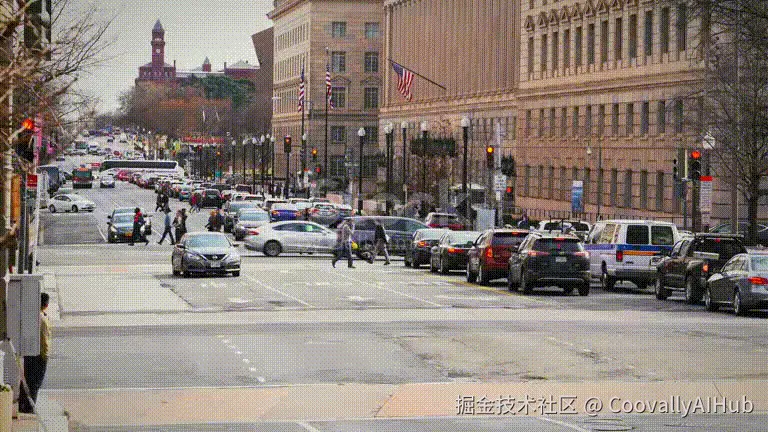在看过一些"能识别视频中每一个物体并持续跟踪"的演示视频后,你可能会以为背后是一套极其复杂的系统。其实,利用 YOLO 模型配合 DeepSort 算法,就能实现无缝的目标检测与跟踪。

如果你不想花时间在环境配置、模型下载、依赖安装这些"开场的麻烦事"上,可以直接用 Coovally 平台------里面已经内置了 YOLOv3/v4/v5/v7/v8/11、Faster R-CNN、RetinaNet、DETR、DeepSort、Mask R-CNN 等主流与前沿检测、跟踪模型,一键加载、自由组合。
YOLO 与 DeepSort 如何协作?
- YOLO 作为 检测器,逐帧运行,输出每个检测目标的边界框位置、类别和置信度。
- DeepSort 作为 跟踪器,接收 YOLO 的检测结果,并结合历史跟踪信息,为每个目标分配唯一 ID,实现跨帧跟踪。
每个跟踪轨迹包含:
- 预测边界框(由卡尔曼滤波器预测)
- 唯一轨迹 ID
- 运动模型(Kalman Filter)
- 外观特征向量(embedding)
由于 YOLO 已经被广泛熟知,下面的重点放在 DeepSort 上。
DeepSort 的核心思想
DeepSort 源自论文 《Simple Online and Realtime Tracking with a Deep Association Metric》 ,是对 SORT 算法的改进版。
- SORT: 依赖卡尔曼滤波(预测目标位置)+ 匈牙利算法(基于 IOU 进行帧间匹配)。
- 缺陷: 遮挡时容易出现 ID 切换(ID Switch)。
- DeepSort 改进: 在匹配时不仅考虑运动信息,还引入外观特征(embedding) ,显著减少 ID 切换。
- 两类关键信息
1.外观特征
- 使用预训练 CNN 提取 128-D 或 256-D 向量,描述目标的外观信息。
- 每一帧中,检测到的目标图像会送入 CNN 提取 embedding。
2.运动信息
- 使用卡尔曼滤波器预测目标的下一位置(位置+速度)。
- 即便目标被部分遮挡,也能通过历史轨迹推测位置。
Tracker 类的核心方法
在 DeepSort 中,Tracker 是主入口类,整合了多个模块(如detection.py、iou_matching.py、linear_assignment.py 等)。
predict()
作用:推进所有轨迹的状态预测一步,通常在每一帧开始时调用。
#
def predict(self):
"""Propagate track state distributions one time step forward.
This function should be called once every time step, before `update`.
"""
for track in self.tracks:
track.predict(self.kf)update(detections)
作用:更新轨迹集,包括匹配检测、标记丢失目标、新建轨迹,并更新度量器。
#
def update(self, detections):
# Run matching cascade.
matches, unmatched_tracks, unmatched_detections = \
self._match(detections)
# Update track set.
for track_idx, detection_idx in matches:
self.tracks[track_idx].update(
self.kf, detections[detection_idx])
for track_idx in unmatched_tracks:
self.tracks[track_idx].mark_missed()
for detection_idx in unmatched_detections:
self._initiate_track(detections[detection_idx])
self.tracks = [t for t in self.tracks if not t.is_deleted()]
# Update distance metric.
active_targets = [t.track_id for t in self.tracks if t.is_confirmed()]
features, targets = [], []
for track in self.tracks:
if not track.is_confirmed():
continue
features += track.features
targets += [track.track_id for _ in track.features]
track.features = []
self.metric.partial_fit(
np.asarray(features), np.asarray(targets), active_targets)_match(detections)
作用:将当前检测与已有轨迹匹配,先用外观+运动特征匹配,再用 IOU 弥补。
#
def _match(self, detections):
def gated_metric(tracks, dets, track_indices, detection_indices):
features = np.array([dets[i].feature for i in detection_indices])
targets = np.array([tracks[i].track_id for i in track_indices])
cost_matrix = self.metric.distance(features, targets)
cost_matrix = linear_assignment.gate_cost_matrix(
self.kf, cost_matrix, tracks, dets, track_indices,
detection_indices)
return cost_matrix
# Split track set into confirmed and unconfirmed tracks.
confirmed_tracks = [
i for i, t in enumerate(self.tracks) if t.is_confirmed()]
unconfirmed_tracks = [
i for i, t in enumerate(self.tracks) if not t.is_confirmed()]
matches_a, unmatched_tracks_a, unmatched_detections = \
linear_assignment.matching_cascade(
gated_metric, self.metric.matching_threshold, self.max_age,
self.tracks, detections, confirmed_tracks)
# Associate remaining tracks together with unconfirmed tracks using IOU.
iou_track_candidates = unconfirmed_tracks + [
k for k in unmatched_tracks_a if
self.tracks[k].time_since_update == 1]
unmatched_tracks_a = [
k for k in unmatched_tracks_a if
self.tracks[k].time_since_update != 1]
matches_b, unmatched_tracks_b, unmatched_detections = \
linear_assignment.min_cost_matching(
iou_matching.iou_cost, self.max_iou_distance, self.tracks,
detections, iou_track_candidates, unmatched_detections)
matches = matches_a + matches_b
unmatched_tracks = list(set(unmatched_tracks_a + unmatched_tracks_b))
return matches, unmatched_tracks, unmatched_detections_initiate_track(detection)
作用:初始化新的轨迹。
#
def _initiate_track(self, detection):
mean, covariance = self.kf.initiate(detection.to_xyah())
self.tracks.append(Track(
mean, covariance, self._next_id, self.n_init, self.max_age,
detection.feature))
self._next_id += 1YOLO + DeepSort 的实际使用
DeepSort 官方仓库原本只用 MOTChallenge 数据集的标注框,不包含检测过程。
如果配合 YOLO 使用:
- YOLO 检测视频每帧中的目标(输出边界框、类别、置信度)。
- 将这些信息传给 DeepSort 进行 ID 分配与轨迹维护。
- 实现高效、连续的目标检测与跟踪。
- 常见应用场景:
- 行人重识别(Re-ID)
- 交通监控
- 智慧零售
- 安防巡检
DeepSort 的 CNN 特征提取器
- 网络结构在 deep_sort/tools/freeze_model.py 中定义(多层卷积+残差模块)。
- 输出 128 维归一化向量(embedding)。
- 训练数据来自 MOT16 + 其他 Re-ID 数据集。
- 训练阶段会额外加分类层预测 ID,但在推理时只保留 embedding 层用于匹配。
总结
YOLO 解决"看见什么"的问题(检测)。
DeepSort 解决"是不是同一个"的问题(跟踪)。
通过结合运动预测(Kalman Filter)与外观特征匹配(CNN embedding),DeepSort 在多目标跟踪任务中大幅降低 ID 切换率,实现更加稳定、流畅的跟踪效果。
如果你已经熟悉 YOLO + DeepSort 的原理,不妨直接在 Coovally 上实践,让算法从"论文和代码"变成"随时可用的工具"。